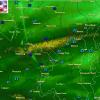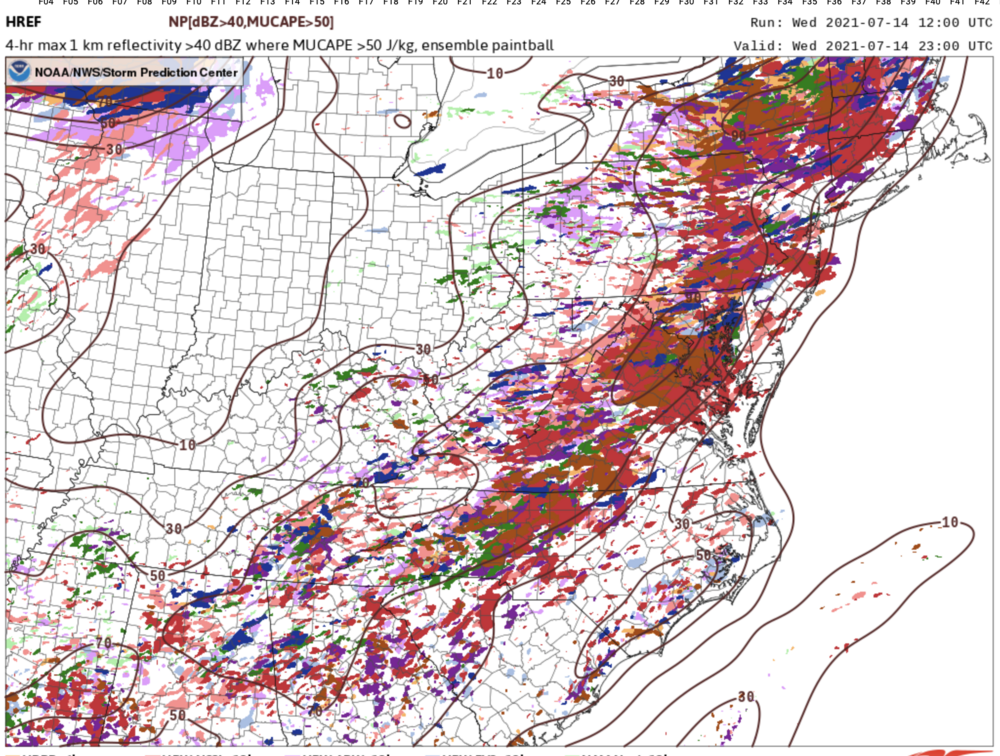-
Posts
2,642 -
Joined
-
Last visited
Content Type
Profiles
Blogs
Forums
American Weather
Media Demo
Store
Gallery
Everything posted by high risk
-
I would think you'll cash in at some point, but it's tough to use the guidance this afternoon, as very few solutions (other than perhaps the ARW2) have a good handle on this lead line.
-
seems like at least a 2 line event. first line filling in from north of Baltimore to west of DC. Line 2 trying to form back to the west. Some guidance hints at a third line later in the evening.
-
hopeful for the scenario of one round of convection late Saturday afternoon and another during the evening hours. If that pans out, anything extra on Sunday will just be a bonus.
-

2021 Mid-Atlantic Severe Weather - General Discussion
high risk replied to Kmlwx's topic in Mid Atlantic
I agree with everyone that the best signals for intense storms are for DC and points south, but there are plenty of CAMs that still have 40 dbz storms north of town. It's reflected in the 12z HREF output which shows a 90% chance between 19 and 23z of 40 dbz within 20 km of a point for much of the area in: To be clear, that's a probably of a storm with 20 km of a point, so the activity could be scattered, but I'll happily take that map. -
Interesting. The guidance had been suggesting that early evening had the best potential over north central MD, and the radar is lighting up.
-
I ended up with a nice storm with a decent soaking - definitely a win. I expected the best chance to occur around now (where there are few cells scattered to my north and northwest, but instability has been somewhat wiped out), but I didn't expect the initial afternoon cells to crank out such a strong outflow boundary that helped initiate storms further south much earlier. But ultimately, the guidance that showed storms generally staying in north/northwest of Howard and Montgomery Counties ended up being pretty accurate.
-
had lots of CGs very close - way out ahead of the rain.
-
It only took about 45 minutes for my earlier post to go to garbage.
-
The southern extent of the watch certainly matches the CAM consensus. Storms may get into the northern parts of Montgomery/Howard later this evening, but it sure seems like it will tough to get things further south.
-
Hug the Hi-Res Window ARW2. That is one of the only CAMs that have storms further south; it seems to have the best handle on those current cells you mentioned, so maybe you've got a shot.
-
Yeah, I'd feel better about storm chances today if I lived along/north of I-70, but Howard County has a shot. You're right that the best shot after today isn't until the end of the week, although there does appear to be a weak shortwave approaching later Wednesday.
-
That may very well be true, but the guidance has been pretty consistent that the threat will be northwest and north of DC Metro. In fact, I'd say that the signal for northern MD is pretty good.
-

2021 Mid-Atlantic Severe Weather - General Discussion
high risk replied to Kmlwx's topic in Mid Atlantic
about to get totally screwed in Howard County...... -

2021 Mid-Atlantic Severe Weather - General Discussion
high risk replied to Kmlwx's topic in Mid Atlantic
Definitely. Somewhat active today and then perhaps active for several days starting Sunday, but Saturday looks like a winner. -

2021 Mid-Atlantic Severe Weather - General Discussion
high risk replied to Kmlwx's topic in Mid Atlantic
Pretty clear signal for afternoon convection tomorrow, and the CAPE/shear combo currently proved would certainly suggest at least some chance of SVR. -
This cell over southern Howard is insane - blinding rain and gusts to 35 kt or so.
-
I can't speak for the Euro, but the new version of the GFS that was implemented in March showed a notable right-of-track bias for TCs in retrospective hurricane season testing, especially for those moving north and then recurving. It has been slowly adjusting to the west with Elsa's track through the southeast and Mid-Atlantic.
-

2021 Atlantic Hurricane Season Tracking Thread
high risk replied to WxWatcher007's topic in Mid Atlantic
Tornadoes are only a threat immediately along and on the east side of the track of the center. There isn't much guidance that takes the center west of the area, although some tracks are further west than others. -

2021 Atlantic Hurricane Season Tracking Thread
high risk replied to WxWatcher007's topic in Mid Atlantic
Yeah, the steering flow along the east coast in the 12z GFS has more of a southerly component than previous runs, which allows Elsa to come further west. It seems to be in response to the midwest upper trough being a little bit stronger. Will be interesting to see whether this cycle is a blip or is legitimately catching on to a trend. -

2021 Mid-Atlantic Severe Weather - General Discussion
high risk replied to Kmlwx's topic in Mid Atlantic
Thanks for continuing the discussion and for posting the sounding. In the big picture for SB vs MLCAPE, MLCAPE seems to be more representative of the air feeding into a storm if the environmental is deeply mixed. Once you go into the evening, and decoupling begins, SBCAPE is arguably more representative, although there are certainly exceptions. In the IAD sounding above, it's certainly not well-mixed, especially with the low-level moisture profile, so perhaps SBCAPE is a better representation, although the higher moisture values drop off quickly above the ground. That moisture profile makes it pretty easy to see why MLCAPE is so much lower.... If, however, a parcel was surface-based, it did have some instability to work with, and there is some decent 0-3 km CAPE to help achieve stronger upward acceleration. Given the earlier rounds of storms, I would have expected the temperature profile to be more moist adiabatic, but it actually had some decent low-level lapse rates. All of that said, I don't understand getting a sustained low-level mesocyclone out of this environment. Deep layer shear was good, and you can make a case for some rotation in the storm. But getting that rotation in the low-levels is an entirely different ballgame, and the low-level shear was meh - confirmed by the unimpressive values of 0-1 and 0-3 km helicity values. Perhaps there was a leftover boundary oriented ESE to WNW through DC, and the storm rode along it, greatly improving the helicity (there was certainly some existing directional shear in the lowest 0.5 km or so). The low LCLs would have greatly improved the chances of getting something to the ground, and that's confirmed by the videos of the storm hugging the ground. The fact that this cell was the only one in the area after dark that went severe argues for some localized enhancement of the environment in that Reston-DC-Bowie corridor. Still, this sounding has sneaky severe potential, but it certainly doesn't scream 'tornado!'. -

2021 Mid-Atlantic Severe Weather - General Discussion
high risk replied to Kmlwx's topic in Mid Atlantic
I don't understand this event at all. The parameters don't seem to support what seems to be a fairly impressive severe event (albeit along a narrow corridor) this evening. -
Definitely. There have been a few lame runs here and there, but guidance has overall been fairly consistent showing that the severe threat was this afternoon, and the threat for widespread heavy rain is in the late evening and overnight hours. Radar shows that this scenario is on track.
-

2021 Mid-Atlantic Severe Weather - General Discussion
high risk replied to Kmlwx's topic in Mid Atlantic
It's worth watching, but by the time it gets here, we will be losing instability (although we'll still have a decent amount of CAPE to work with), and the shear is not nearly as good here as it is further northwest. Heck, the shear isn't even very good where the watch just got issued. If, however, a sfc cold pool can become established, the line can organize better. and we would have some modest severe potential in a few hours. The HRRR runs haven't been too excited, but the 18z NAM nest looks robust. -

2021 Mid-Atlantic Severe Weather - General Discussion
high risk replied to Kmlwx's topic in Mid Atlantic
yeah, even if we don't focus on potential significant UH swaths, the signal for widespread, organized convection in the early/mid afternoon hours tomorrow is robust across the CAMs. The shear/instability profile combo should be sufficient for some of that to become severe. The only "concern" is weak lapse rates shown in several models, but I like our chances of being upgraded to SLGT in the new day 2 outlook. -

2021 Mid-Atlantic Severe Weather - General Discussion
high risk replied to Kmlwx's topic in Mid Atlantic
Looks to me like Thursday afternoon has a good chance to eventually become a SLGT. Lapse rates aren't great, but the timing looks favorable, and the shear/instability combo as current progged would likely generate SVR. Expecting a very heavy rain threat too, particularly as additional rounds of convection move over the area after dark.





